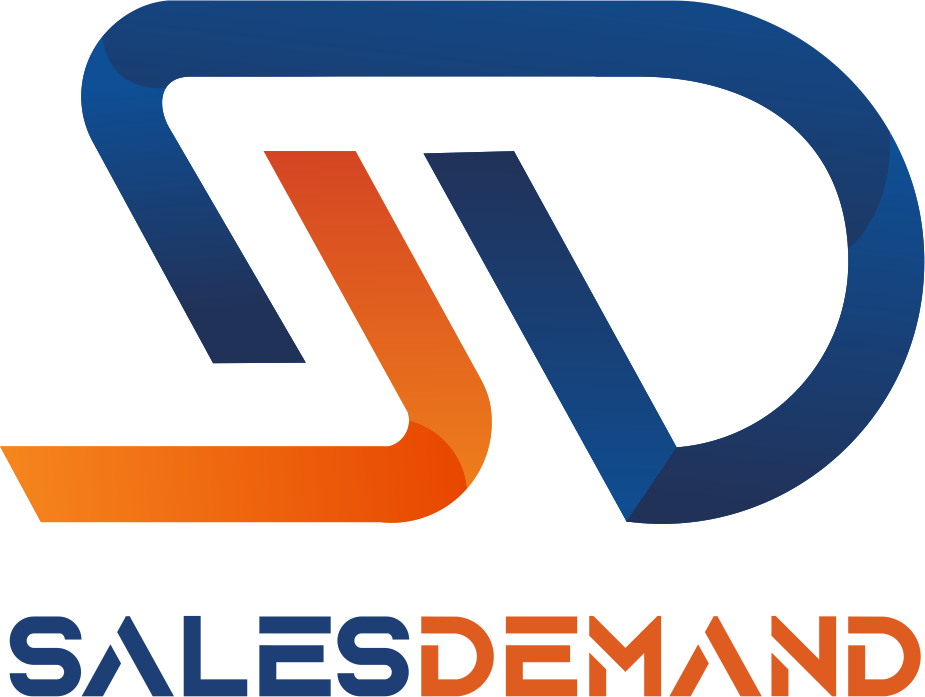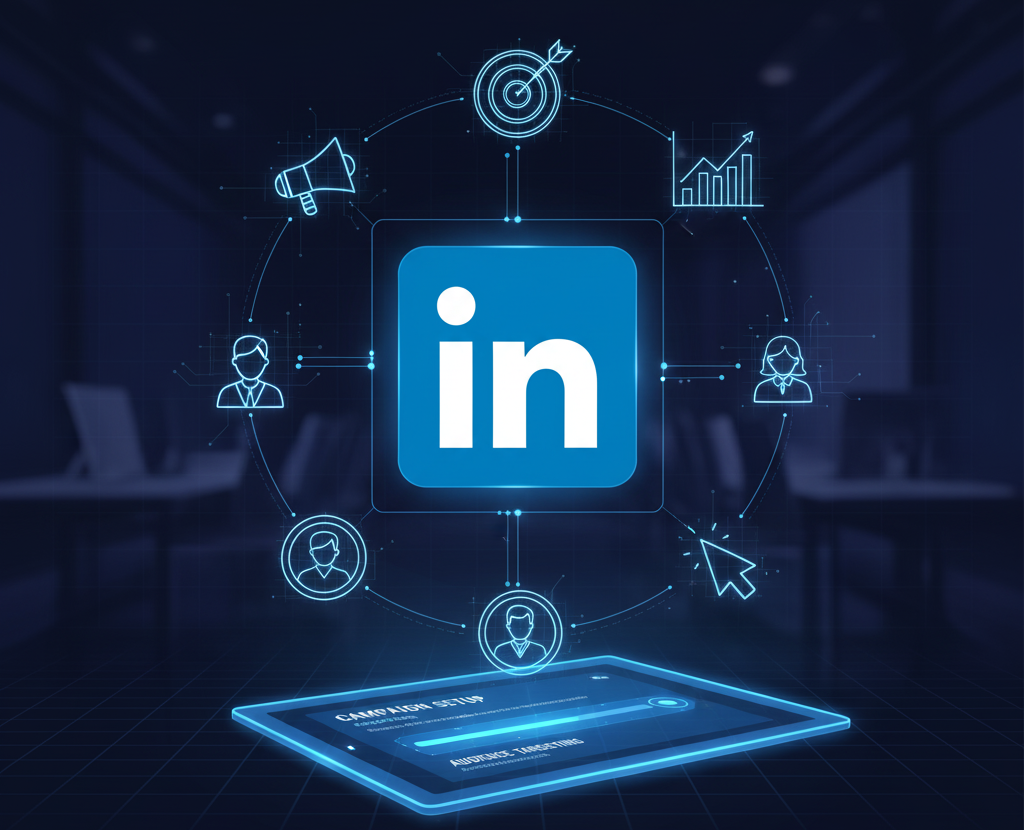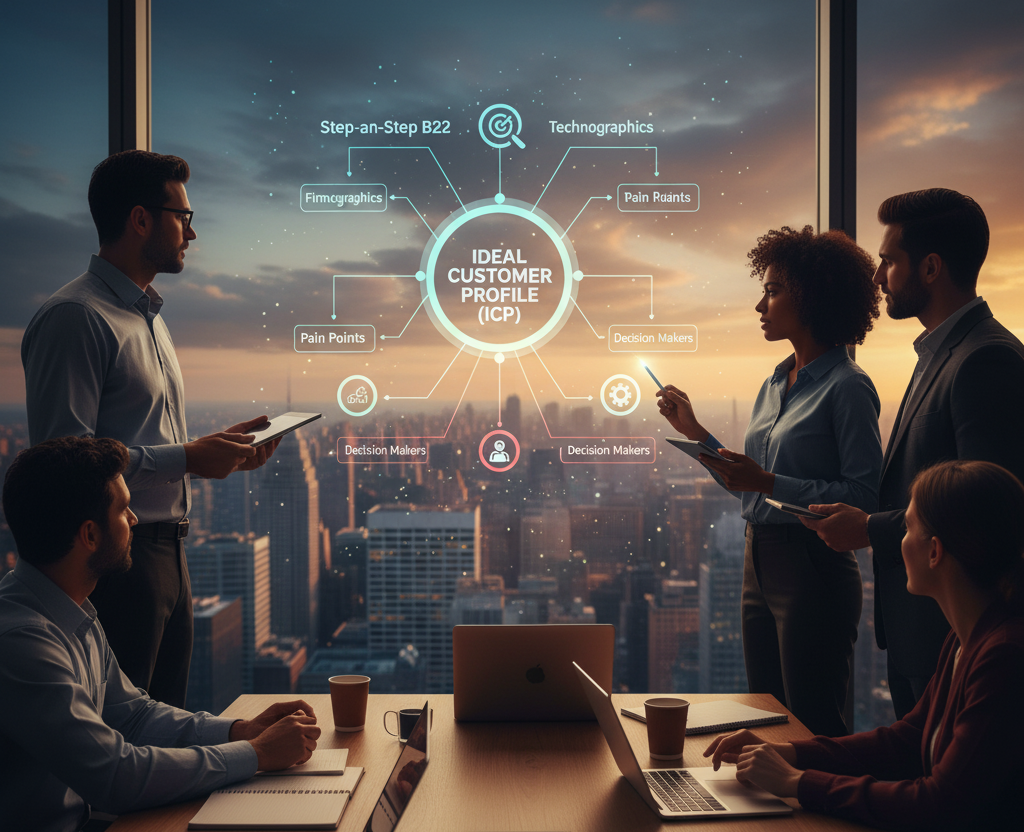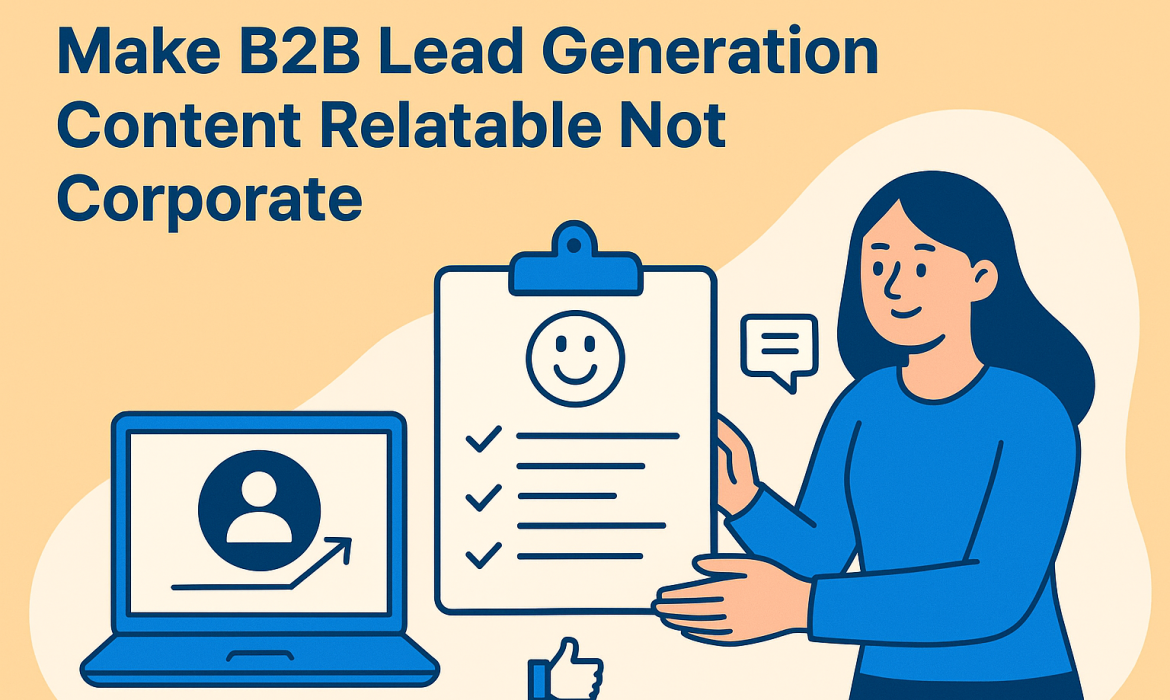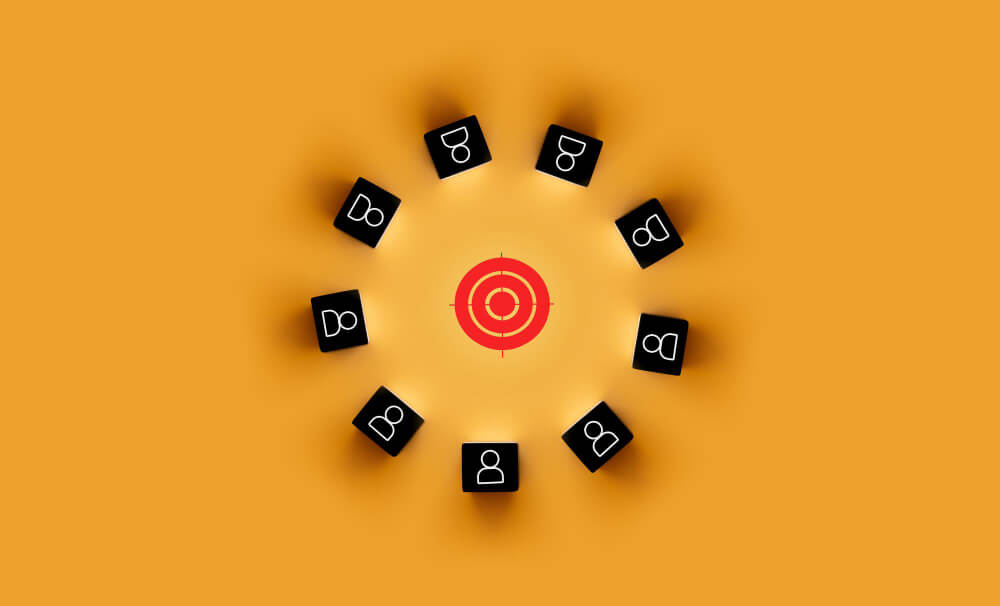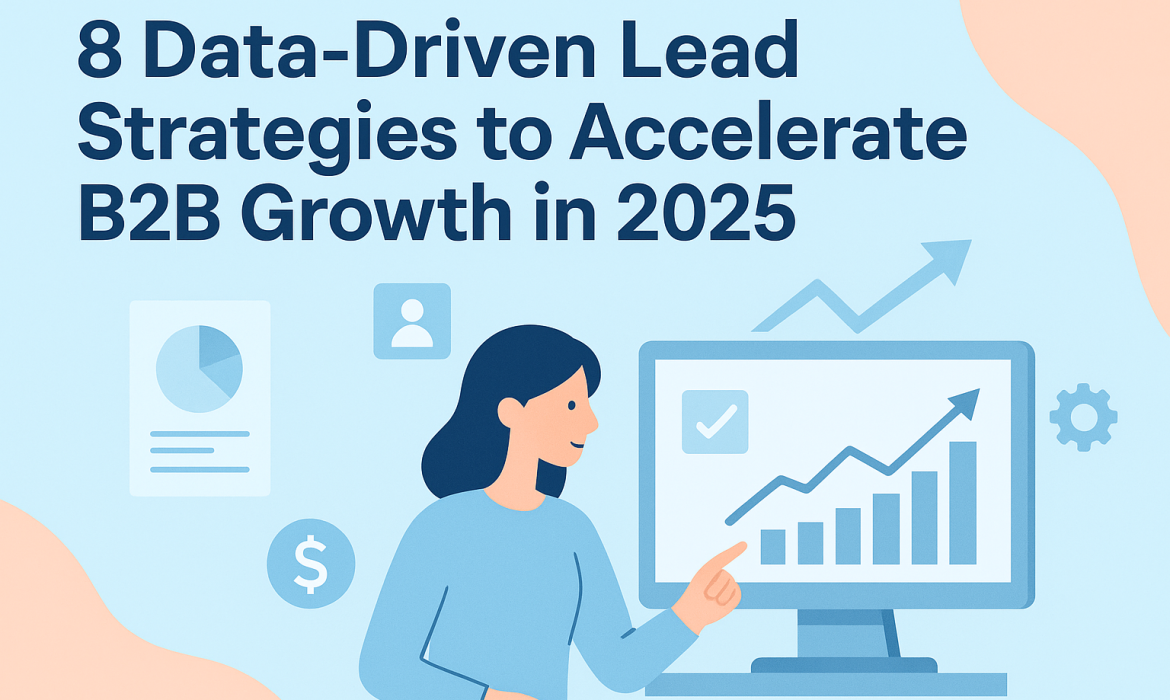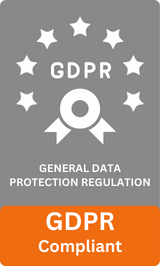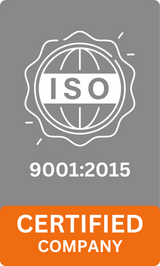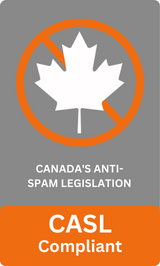5 Best AI Tools Transforming B2B Teams in 2025
In 2025, artificial intelligence isn’t just an optional upgrade, it has become the engine driving every high-performing B2B team. The most successful organizations are using AI to automate repetitive work, boost productivity, and make smarter, data-backed decisions. From automating lead qualification and content creation to enhancing customer engagement, AI is changing the way sales and marketing collaborate. The difference between teams that are scaling fast and those that are struggling often comes down to the tools they use and how intelligently they use them.
Today’s AI-powered platforms are not only automating workflows but also redefining strategy. For B2B leaders, it’s no longer about adding tools, it’s about integrating the right ones that can multiply impact. Let’s explore five of the best AI tools that are redefining how B2B teams work, innovate, and grow in 2025.
These 5 Best AI Tools are Transforming B2B
1. ChatGPT
The first and most widely recognized tool is ChatGPT. While initially known for conversational AI, ChatGPT has evolved into a business co-pilot. For B2B teams, it streamlines research, drafts emails, generates proposals, and even writes outreach scripts in minutes. Sales teams are using it to personalize client communication at scale, while marketers are leveraging it to generate blog ideas, optimize SEO, and summarize large amounts of market data. What sets ChatGPT apart is its ability to adapt to brand voice and context, making every piece of content sound human and aligned with company tone. Integrated with CRMs and workflow tools, it can reduce manual writing time by over 40%, freeing teams to focus on strategy instead of scripting.
2. Jasper AI
Next on the list is Jasper AI, a creative powerhouse tailored for content marketers and brand teams. Jasper combines AI writing with style customization, SEO optimization, and collaboration tools. For B2B marketers handling multi-channel campaigns, Jasper simplifies the process of creating high-performing copy across websites, emails, and social posts. Its ability to learn brand guidelines ensures consistency, which is critical for B2B communication where credibility is key. Many organizations report cutting down campaign production time by half, while improving content engagement rates by 25%. Jasper also integrates with SurferSEO and HubSpot, making it ideal for teams that want speed without sacrificing precision or tone.
3. HubSpot AI
HubSpot AI comes next as a game-changer in marketing automation. HubSpot’s built-in AI now powers lead scoring, content personalization, predictive analytics, and campaign optimization. For B2B teams, this means having data-backed insights about which leads are most likely to convert, which content resonates best, and when to reach out. HubSpot AI transforms a typical CRM into a growth engine, analyzing behavior patterns, suggesting outreach improvements, and automating responses in real-time. Businesses have seen up to 30% faster lead responses and improved pipeline forecasting accuracy. In short, it takes guesswork out of marketing decisions and replaces it with clarity and confidence.
4. Apollo AI
Apollo AI, another standout, is redefining how B2B sales teams identify and reach prospects. It combines prospect intelligence with automated outreach and engagement scoring. Apollo’s AI can identify ideal customer profiles based on data from millions of contacts, helping teams target with laser precision. It can also write hyper-personalized outreach messages that improve reply rates and shorten sales cycles. By automating lead research and sequencing, sales teams have reported saving over 20 hours a week while increasing conversion rates by up to 35%. The platform’s integration with CRMs ensures a seamless experience from discovery to deal closure, making it one of the most practical AI investments for modern sales operations.
5. Notion AI
Rounding out the list is Notion AI, a quiet but powerful tool that supports B2B teams behind the scenes. Notion AI enhances productivity and knowledge management by automating meeting summaries, project documentation, and content ideation. For teams that collaborate across functions, it ensures that notes, updates, and plans are always organized and accessible. Its ability to summarize and connect ideas helps leaders make informed decisions faster. Many marketing and operations teams now rely on Notion AI as their internal intelligence hub, saving 30% of time previously spent on admin work and information management.
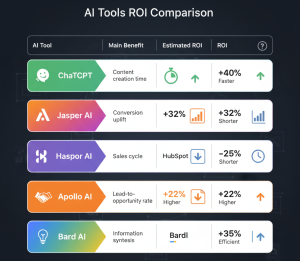
How Leading AI Tools Deliver Measurable ROI for B2B Teams
While every AI tool brings its own strengths, their true impact is best understood through measurable results. B2B teams across industries are reporting faster workflows, higher engagement, and smarter decision-making thanks to these intelligent platforms. The following snapshot highlights how leading AI tools are delivering real ROI in 2025.
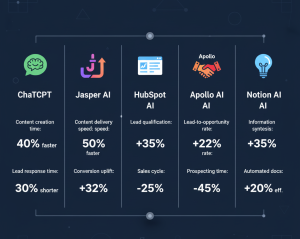
These numbers reveal a clear pattern, AI isn’t just improving efficiency; it’s transforming how B2B teams operate. The tools that combine intelligence with usability are enabling businesses to scale faster, collaborate better, and achieve consistent growth across every function.
The Future of AI in B2B: Collaboration Over Competition
As impressive as these statistics are, the true power of AI lies not only in the tools themselves but in how teams use them together. Forward-thinking organizations are blending multiple AI systems into one ecosystem, connecting marketing automation, content creation, and CRM analytics to deliver end-to-end efficiency. When ChatGPT’s creativity meets HubSpot’s analytics and Apollo’s targeting, the result is a seamless customer journey built on intelligence and personalization.
The shift we’re witnessing in 2025 is not just technological, it’s strategic. AI is no longer a tool that works in the background; it’s becoming an active collaborator. B2B teams that embrace it as a partner are seeing measurable improvements in response rates, deal velocity, and team morale. The once manual, linear sales and marketing process is now dynamic, predictive, and personalized. The efficiency gains are measurable, but the cultural impact, teams feeling more creative, informed, and empowered, is equally valuable.
As we move toward 2026, the next evolution of AI in B2B will focus on deeper integration and ethical intelligence. Tools will not only predict behavior but also ensure that decisions align with fairness and compliance. Data transparency, bias detection, and responsible automation will define the next phase of AI transformation. Companies that invest early in AI literacy and governance will hold a strategic advantage, knowing how to scale responsibly while maintaining customer trust.
AI is changing the rhythm of B2B operations. It’s helping leaders make faster decisions, personalize customer interactions, and unlock time for creative problem-solving. But success with AI isn’t about chasing every new tool; it’s about mastering the right ones that align with business goals. Whether it’s ChatGPT drafting personalized proposals, Jasper refining brand tone, HubSpot predicting buyer intent, Apollo finding the perfect lead, or Notion keeping teams aligned, each of these tools adds a new layer of intelligence to the B2B ecosystem.
The future belongs to teams that learn to collaborate with AI, not compete with it. By using these tools strategically, B2B leaders can turn technology into a growth partner rather than a replacement for human intuition. AI may power the processes, but people still drive the purpose, and that’s where the winning edge lies.
Conclusion:
The evolution of AI in B2B isn’t about replacing human intelligence, it’s about amplifying it. As teams integrate the right tools with strategy and empathy, they’ll move beyond automation toward true innovation. In 2026 and beyond, the most successful B2B organizations won’t just use AI, they’ll partner with it to build smarter, faster, and more human-centered growth.
I hope you find the above content helpful. For more such informative content, please visit SalesDemand.
FAQs:
1. Which AI tool is best for B2B content marketing?
Jasper AI and ChatGPT are top choices for generating personalized, brand-aligned B2B content quickly and efficiently.
2. Can AI improve B2B lead conversion rates?
Yes. Tools like Apollo AI and HubSpot AI use predictive analytics and automation to identify high-potential leads and increase conversion.
3. How can small B2B teams use AI effectively?
Start with scalable tools like ChatGPT or Notion AI to automate routine work and then integrate analytics tools as you grow.
4. Are these AI tools easy to integrate with CRMs?
Most modern AI tools, including HubSpot and Apollo, offer plug-and-play integrations with common CRM platforms.
5. What’s next for AI in B2B operations?
Future trends include responsible AI, predictive personalization, and deeper cross-platform data integration for unified decision-making.
Demand Gen vs Lead Gen in B2B Marketing
The way B2B marketing works today is very different from what it was a few years ago. Companies are investing more in building brand awareness and creating trust before asking for sales. According to eMarketer, nearly 40% of B2B marketers plan to increase their brand-building budgets in 2025. At the same time, 49% of marketers say generating more leads is their top priority, but 41% find it to be their biggest challenge.
This is where the confusion between demand generation and lead generation often starts. Many think they’re the same, but they serve different purposes. Demand generation focuses on creating awareness and interest, while lead generation turns that interest into real prospects and potential customers.
In this blog, we’ll clearly explain what each of these strategies means, how they differ, how they work together, and which approach will help your business grow in 2025 and beyond.
What Is Demand Generation?
Demand generation (or demand gen) is a broad marketing strategy aimed at creating awareness, sparking interest, and building trust for your brand or solution. It’s about reaching potential customers who may not yet know your company or be ready to buy.
In B2B contexts, demand gen often focuses on educating the market, positioning your brand as a thought leader, and nurturing relationships over time.
- Content marketing (blogs, videos, webinars)
- Brand awareness and authority building
- Top-of-funnel activities like social engagement and search visibility
- Long-term nurturing rather than immediate conversions
What Is Lead Generation?
Lead generation (or lead gen) is more targeted: it aims to capture interest from prospects who are somewhat aware of your solution and guide them into your pipeline.
Lead gen is about converting interest into actionable contacts.
In a B2B setting, lead gen often includes:
- Gated offers (eBooks, white papers, demo requests)
- Landing pages with forms
- Qualification of leads (MQLs, SQLs)
Middle- and lower-funnel activities designed to convert interest into opportunity
The aim of lead gen is to provide the sales team with prospects that are ready to engage and move toward purchase.
Key Differences Between Demand Generation and Lead Generation
When comparing demand gen vs lead gen, you’ll find several key distinctions:
Dimension Demand Generation Lead Generation
Funnel stage Top-of-funnel; awareness & interest Middle or bottom; conversion of interested prospects
Primary goal Build brand visibility, educate audience, stimulate demand Capture leads, qualify prospects and drive sales-ready contacts
Typical metrics Website traffic, engagements, brand searches, top-funnel reach Number of leads, cost per lead, conversion rates, MQLs/SQLs
Content approach Ungated, educational, broad audience Gated, action-oriented, targeted to prospects with intent
Time horizon Long-term; builds momentum over months/years Shorter term; aims for immediate interest and conversion
Role in pipeline Creates the pool of potential prospects Converts those prospects into actionable leads
Because demand generation builds the foundation, lead generation often becomes ineffective if demand generation is neglected. Without top-of-funnel awareness, the pipeline can dry up.
How Demand Generation Fuels Lead Generation
The relationship between demand generation and lead generation is not one of competition but of complementarity. Demand gen sets the stage; lead gen executes the conversion. Here’s how demand gen fuels lead gen:
- Demand gen creates awareness and primes prospects. When a brand is known, lead gen has more fertile ground.
- Content created via demand gen can feed into lead gen assets (e.g., blog posts become lead magnets).
- Demand-generated interest allows lead gen efforts to target more qualified audiences, reducing waste and improving conversion.
- With stronger demand gen, lead gen costs (like cost per lead) can decrease because prospects are warmer.
- According to multiple sources, if you skip demand generation and jump straight to lead capture, the conversion rates suffer.
Demand Generation Strategies That Work in 2025
To stay ahead in 2025, B2B marketers must evolve their demand generation strategies. Here are effective tactics:
1. Thought Leadership & Executive Branding
- Publish commentary, op-eds, LinkedIn articles by senior leaders.
- Use webinars and podcasts to position your brand as authority.
2. SEO-Founded Content Ecosystem
- Create ungated content optimized for high-intent keywords.
- Focus on solving customer pain-points early in the journey.
3. Community & Influencer Engagement
- Build or participate in niche communities (Slack, LinkedIn Groups) relevant to your ICP.
- Partner with industry influencers to amplify reach.
4. Account-Based Marketing (ABM) & Intent Data
- Leverage account signals to generate demand within target companies.
- Use intent data to personalize content and outreach across the funnel.
5. Interactive & Immersive Experiences
- Use tools like virtual events, live Q&A, immersive demos to engage prospects.
- Offer interactive content (assessments, calculators) that provide value without gating.
6. Cross-Channel Storytelling
- Integrate digital, offline (events), and social channels into unified campaigns.
- Maintain consistency of messaging and branding across touch-points.
7. Measurement Beyond Leads
- Track engagement metrics like time on content, repeat visits, brand search lift.
- Align marketing and sales data to evaluate how demand gen converts into pipeline.
Successful 2025 demand gen campaigns emphasise brand-influence, education, and value rather than pure direct response.
Effective Lead Generation Tactics for B2B and B2C Brands
While many of these focus on B2B, they can also apply in B2C contexts with adaptation. Here’s what works:
For B2B Brands:
- High-value gated assets: eBooks, white papers, case studies.
- Demo requests and product trials targeted at decision-makers.
- Webinars with registration and follow-up sequences.
- Landing pages optimized for conversions with clear CTAs and segmentation.
- Lead scoring and nurturing workflows via CRM and marketing automation.
For B2C Brands:
- Newsletter subscriptions, discount offers, quiz tools to capture interest.
- Retargeting ads to website visitors, look-alike audiences.
- Lead magnets like free samples, entries to contests, downloadable guides.
- Chatbots for real-time engagement and capturing enquiries.
Shared Tactics:
- Clear CTA and simple form design to minimize friction.
- Segmentation to ensure relevance of offers based on prospect behaviour.
- A/B testing of landing pages, forms, email nurture sequences.
- Alignment between marketing and sales: ensuring handoff of qualified leads is smooth.
Lead gen tactics must integrate seamlessly with demand gen efforts; otherwise, you’ll have high volumes of unqualified leads or poor conversion.
Which Strategy Is Right for Your Business? (Or How to Balance Both)
Choosing between demand gen vs lead gen isn’t an either-or proposition. Most successful B2B organisations use both. Here’s a framework to decide and balance:
- Stage of business & market maturity: If your brand is new or entering a new market, lean heavier on demand gen initially to build awareness. If you’re established and want to scale the pipeline fast, lead gen takes centre stage.
- Budget and resources: Demand gen often requires more time, consistent content, and brand building. Lead gen may yield quicker measurable results but needs solid demand pre-work.
- Target audience behaviour: If your buyers spend a long time researching (typical B2B), demand gen is critical. For impulse or shorter-cycle purchases (common B2C), lead gen may dominate.
- Sales-marketing alignment: Both strategies demand tight integration of marketing and sales teams. If handoff gaps exist, your lead gen suffers even if demand gen is strong.
- Measurement maturity: If you can track funnel metrics, attribution and pipeline, you can calibrate both. Otherwise, start with simpler lead gen while building measurement for demand gen.
Conclusion
In B2B marketing today, the debate around demand gen vs lead gen is not about choosing one over the other, it’s about integrating both intelligently. Demand generation builds the foundation by creating awareness, establishing trust and educating the market. Lead generation steps in to convert that awareness into actionable opportunities and revenue.
By developing a strategy that aligns both, supported by robust measurement, clear processes, and alignment between marketing and sales, businesses in India and internationally can maximise growth. Remember: without demand, lead gen becomes inefficient; without lead gen, demand remains unrealised. The future belongs to those who master both.
I hope you find the above content helpful. For more such informative content, please visit SalesDemand.
FAQs
1. What’s the main difference between demand gen and lead gen?
Demand generation focuses on awareness and interest, while lead generation focuses on capturing and converting those interested prospects.
2.Can a company do lead generation without demand generation?
Yes, but it often leads to higher costs and lower conversion rates because the prospects aren’t primed or aware of your solution.
3. Which tactic is better for a startup?
For a startup, focusing initially on demand generation makes sense to build recognition. Once awareness is established, investing in lead gen will yield better results.
4. How should a B2C brand use these strategies differently compared to B2B?
In B2C, lead gen may dominate due to shorter purchase cycles and higher impulse purchases. Demand gen still matters for brand building and loyalty but may operate faster and more mass-market than in B2B.
5. Which metrics should I track for demand gen vs lead gen?
For demand gen: brand search lift, website traffic, engagement rates. For lead gen: number of leads, conversion rate, cost per lead, MQL to SQL conversion.
A Beginner’s Guide to LinkedIn Ads
LinkedIn is the largest professional network in the world, with over 900 million users across the globe. It serves as a crucial platform for B2B marketers who want to reach decision-makers, business owners, and professionals who influence purchasing decisions. Unlike other social media channels, LinkedIn allows businesses to target audiences based on professional attributes such as job title, company size, and industry, making it an ideal platform for lead generation and business growth.
For those new to advertising on LinkedIn, the platform can seem overwhelming due to its various ad types, targeting capabilities, and budget management options. This guide provides a comprehensive roadmap for LinkedIn Ads for Beginners, detailing each step required to create, manage, and optimize effective campaigns that generate measurable results.
Set Clear Goals & KPIs
Before initiating a LinkedIn ad campaign, it is critical to define the goals and key performance indicators (KPIs) that will measure success. Campaigns without clear objectives often underperform and fail to deliver tangible results. Goals help align the campaign strategy with broader business objectives and guide decision-making at every stage.
KPIs to consider when planning LinkedIn advertising campaigns include:
- Clicks: Measures user engagement with the ad.
- Conversions: Tracks actions like form submissions, demo requests, or downloads.
- Cost per Lead (CPL): Indicates the efficiency of the campaign in acquiring leads.
- Impressions & Reach: Monitors the number of users exposed to the ad.
Defining these metrics from the start ensures that the campaign is structured for measurable outcomes and facilitates performance evaluation.
Pick Your Objective
Selecting the right campaign objective is fundamental for LinkedIn advertising. The objective determines how LinkedIn’s delivery algorithm optimizes the campaign and influences which users are targeted.
Common objectives include:
- Awareness: Increases brand visibility among the target professional audience.
- Consideration: Drives engagement through website visits, video views, or content interactions.
- Conversions: Encourages lead collection, demo requests, or other measurable actions.
Setting the correct objective ensures that the advertising efforts are aligned with business goals and allows marketers to track the effectiveness of campaigns accurately.
Target the Right People
One of LinkedIn’s most significant advantages is its precise targeting capabilities. Unlike other platforms, LinkedIn allows advertisers to reach audiences based on professional attributes rather than general interests, making it highly suitable for B2B marketing.
Targeting parameters available to advertisers include:
- Job Title / Function: Enables targeting of decision-makers or employees relevant to the product or service.
- Industry & Company Size: Focuses on organizations that align with the ideal customer profile.
- Location & Seniority: Targets professionals based on geographical location and level of responsibility.
- Groups & Interests: Targets members of LinkedIn groups or those with professional interests relevant to the business.
Effective audience targeting ensures that the ads are shown to users most likely to engage, enhancing campaign performance and reducing unnecessary ad spend.
Choose Your Ad Type
LinkedIn provides multiple ad formats that serve different marketing objectives. Selecting the correct ad type is essential to ensure that campaigns achieve the desired results.
Available ad formats include:
- Sponsored Content: Native posts displayed directly in the LinkedIn feed. Suitable for driving engagement and increasing brand awareness.
- Message Ads: Delivered directly to a user’s LinkedIn inbox to generate leads or encourage action.
- Text Ads: Displayed in sidebars for brand exposure and simple engagement.
- Dynamic Ads: Personalized advertisements automatically customized for each viewer to promote engagement and followership.
Understanding the differences between these ad formats allows marketers to select the format most appropriate for their objectives, thereby improving the effectiveness of their campaigns.
Craft Your Ad Copy & Visuals
The quality of ad copy and visuals significantly impacts campaign performance. Effective messaging should clearly communicate the value proposition, while visuals should capture attention and maintain professionalism.
Ad copy should include a concise and clear description of the benefits offered, accompanied by actionable calls-to-action. Visual elements such as images or videos should be high-quality and directly relevant to the campaign objective. Proper alignment between copy and visuals ensures the message resonates with the target audience.
Budget & Schedule
Managing budget and schedule is a critical component of successful LinkedIn campaigns. Advertisers can choose between different payment models:
- Cost per Click (CPC): Payment is made only when a user clicks on the ad.
- Cost per Impression (CPM): Payment is made for every thousand impressions.
A strategic approach to budget allocation involves starting with a moderate daily budget and monitoring campaign performance over a defined period. Scheduling should be optimized to ensure ads are delivered continuously or during periods when the target audience is most active. This approach allows marketers to maximize efficiency and control costs effectively.
Launch & Track Performance
After campaign launch, monitoring performance metrics is essential for assessing effectiveness. LinkedIn Campaign Manager provides detailed analytics, including impressions, click-through rates, conversions, and cost metrics.
Tracking these metrics enables marketers to identify which elements of the campaign are performing well and which require adjustments. Monitoring performance consistently ensures that campaigns remain aligned with goals and deliver measurable outcomes.
Optimize & Iterate
Optimization involves making data-driven adjustments to improve campaign performance. This can include refining audience targeting, adjusting ad copy or visuals, and reallocating budget to better-performing campaigns. Iterative optimization ensures that campaigns become progressively more efficient and effective over time.
Install LinkedIn Insight Tag
The LinkedIn Insight Tag is a snippet of code added to the website to facilitate advanced tracking. It provides valuable data on user interactions, conversions, and engagement with ad campaigns. This data allows advertisers to measure ROI accurately and supports advanced marketing strategies such as retargeting and audience segmentation.
Retarget Engaged Users
Retargeting is the process of re-engaging users who have previously interacted with ads or visited the website. This approach increases the likelihood of conversions by reinforcing brand awareness and encouraging action among users who have already demonstrated interest. Effective retargeting strategies are crucial for maximizing return on investment from LinkedIn ad campaigns.
Conclusion
LinkedIn advertising provides B2B marketers with the tools to reach decision-makers, generate qualified leads, and grow business effectively. For beginners, understanding the platform and its various components is essential for success. By following a structured approach that includes setting goals, selecting objectives, targeting audiences, crafting ad copy, managing budgets, monitoring performance, optimizing campaigns, and leveraging tracking tools, beginners can launch campaigns that deliver measurable results.
With consistent implementation and gradual scaling, LinkedIn Ads for Beginners can become a powerful channel for driving business growth and lead generation.
FAQs
1. What are LinkedIn Ads for Beginners?
LinkedIn Ads for Beginners are paid advertising campaigns designed to help new advertisers reach professional audiences on LinkedIn with clear, actionable steps.
2. How much should beginners budget for LinkedIn ads?
Budgeting depends on campaign goals, but starting with a moderate daily budget and analyzing performance over at least one week is recommended.
3. Which ad type is best for beginners?
Sponsored Content is recommended for beginners due to its high engagement potential, visibility in feeds, and ease of tracking results.
4. How can I track performance for LinkedIn ads?
Performance can be tracked through LinkedIn Campaign Manager, which provides metrics such as impressions, clicks, CTR, conversions, and cost per lead.
A Step-by-Step Guide to Defining Your B2B ICP
Think of the world’s most successful B2B firms. They don’t just have great products; they have unwavering focus. In today’s hyper-competitive global landscape, particularly for businesses serving diverse markets from Bangalore to Boston, precision is the ultimate competitive advantage. Trying to sell your complex solution to every company that shows slight interest is a fast track to resource drain, misaligned teams, and ultimately, stagnated growth.
The critical tool that separates the market leaders from the laggards is the B2B Ideal Customer Profile (ICP).
The ICP isn’t just an exercise in market segmentation; it’s the single unifying document that ensures your Marketing, Sales, and Product teams are all marching toward the same high-value accounts. It transforms your strategy from broad, expensive outreach into a targeted, high-return operation.
Ready to stop wasting time on low-fit prospects and start building a predictable, high-LTV revenue engine? This guide gives you the step-by-step blueprint to master your ICP and unlock your company’s true growth potential.
1. Why Your Business Needs a Laser-Focused ICP
What is an ICP?
An B2B Ideal Customer Profile (ICP) is a detailed, composite description of the type of company that receives the most significant value from your offerings and, consequently, provides the greatest long-term value (LTV) back to your business.
It’s crucial to distinguish this from a Buyer Persona. The ICP focuses on the company’s characteristics (e.g., firmographics, technographics), while the Buyer Persona focuses on the individual’s motivations and role.
| Feature | Ideal Customer Profile (ICP) | Buyer Persona |
|---|---|---|
| Focus | The Company (B2B entity) | The Individual (Decision-Maker/Stakeholder) |
| Data Points | Firmographics, Technographics, Pain Points | Role, Title, Motivations, Challenges, Goals |
| Goal | Defines who to target to maximize LTV. | Defines how to message to convince the individual. |
The Tangible Benefits: Why It’s Non-Negotiable
When you ignore your ICP, you waste effort and budget on low-value leads. Conversely, a clear B2B Ideal Customer Profile (ICP) is the strategic tool that empowers your entire organization:
- Elevated Marketing ROI – Crafting campaigns that resonate deeply with precisely the right companies. This leads to higher engagement, better lead quality, and significantly reduced wasted ad spend.
- Accelerated Sales Cycles – Your sales team stops chasing unqualified leads. Instead, they focus their energy on prospects genuinely poised for conversion, resulting in faster deal closures and more accurate forecasting.
- Fortified Customer Retention & LTV – When you onboard clients who are a perfect fit, they naturally experience greater success with your solution. This translates to higher satisfaction, reduced churn, and a substantial increase in customer lifetime value.
2. Unearthing Your Best Customers: The Data Dive
The journey to defining your ICP begins by looking inward, at your existing client base. Your most successful customers already hold the clues to your future success.
Before you project your ideal, assess your reality. Identify your most successful, profitable, and loyal customers. This isn’t just about who pays the most; it’s about who thrives with your solution and champions your brand.
Key Data Points for Your Analysis:
- Revenue & Profitability – Which accounts generate the highest Annual Contract Value (ACV) and contribute most positively to your net profit?
- Retention & Loyalty – Which clients have demonstrated the longest tenure and consistently renew their contracts?
- Advocacy & Referrals – Who willingly provides testimonials, participates in case studies, or refers to new business?
Tools such as your CRM system, sales reports, and customer analytics platforms are indispensable for gathering this crucial data efficiently.
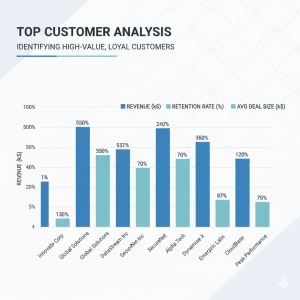
3. Building the Blueprint: Defining Company DNA
Once you’ve isolated your best clients, it’s time to abstract their common characteristics and build the core profile.
Decoding Firmographics: Essential Business Attributes
Firmographics are the organizational DNA, helping you segment the vast B2B market into actionable groups. These are the non-negotiable filters for your lead lists.
Essential Firmographic Attributes:
- Industry/Vertical – What sectors are your top customers in? (e.g., FinTech, E-commerce, Logistics). This is often the most restrictive and important filter.
- Company Size – Defined by Employee Count (e.g., 500-2,000 employees) or Annual Revenue (e.g., $10M – $50M).
- Geographic Location – Are your services optimized for specific regions (e.g., India’s metropolitan clusters, US East Coast) due to regulation or language?
- Growth Stage – Are they rapidly scaling (scale-ups) or mature, established enterprises?
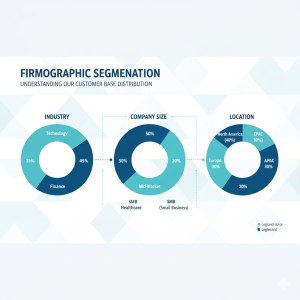
Technographic Insights: Unmasking Their Tech Stack
For any modern B2B solution, especially those involving software, understanding the target company’s current technology landscape is paramount. Technographics reveal compatibility and integration needs.
Key Technographic Indicators:
- Current Software in Use – Do they use a specific CRM (Salesforce, Zoho), ERP (SAP, Oracle), or marketing automation tool (HubSpot, Marketo)?
- Compatibility – Does your product require a mandatory integration that your best customers already have in place?
- Tech Adoption – Are they willing to try new technology, or do they prefer established, legacy systems?
Combining this technical profile with behavioral data is extremely effective for predicting conversion likelihood.
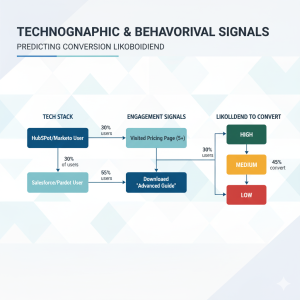
4. Solving Real Problems: Aligning Value & Need
Your ICP should be defined not by what they are, but by the magnitude of the problems they face that your product solves. If the pain is minor, your solution will never be a priority purchase.
Identifying Core Pain Points: Where Does Your Solution Shine?
Focus your research on the costly and complex challenges that necessitate external help. This forms the bedrock of your messaging.
High-Priority Pain Point Categories:
- Operational Inefficiencies – Excessive manual tasks or broken processes costing them time and money.
- Scalability Roadblocks – Infrastructure or systems that cannot handle anticipated growth or demand spikes.
- Regulatory/Compliance Stress – Specific industry requirements (common in FinTech and Healthcare) that your solution mitigates.
Mapping Value Proposition: The Product-Market Fit Matrix
Once you have the pain points, you must visually confirm the alignment with your product’s core features. This verifies your product-market fit within the context of your ideal client.
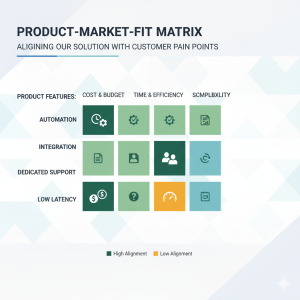
5. Navigating the Decision Maze: Understanding the Buying Unit
In B2B sales, purchasing is rarely a solo endeavor. Your B2B Ideal Customer Profile (ICP) must include a detailed map of the Decision-Making Unit (DMU) within the target company.
Inside the DMU: Who Holds the Keys to Purchase?
You must identify the roles and motivations of the stakeholders involved to ensure your marketing and sales campaigns address all concerns.
- The Economic Buyer (The Signer) – Focused on ROI, budget, and strategic impact. Messaging Focus: Financial gain and risk mitigation.
- The Champion (The End-User/Advocate) – Focused on daily efficiency, ease of use, and professional success. Messaging Focus: Usability and functionality benefits.
- The Influencers (Technical/Security Veto) – Focused on integration, security, compliance, and compatibility. Messaging Focus: Seamless integration and robust security.
Crafting Targeted Messaging for Each Stakeholder
By mapping these roles, you ensure your marketing materials and sales presentations are tailored. For example, a campaign targeting the ICP‘s CIO would focus on security and scalability, while a campaign targeting the Head of Operations would focus on efficiency and automation.
6. Refining Your Focus: Prioritization & Validation
The final stage involves turning raw data into a usable, prioritized system and setting up a mechanism for continuous improvement.
Scoring Your Ideal Client: Building a Robust ICP Scorecard
Not all companies that fit your criteria are equal. A robust scoring system helps your sales team direct their energy toward the “A-Tier” accounts with the highest probability of conversion and LTV.
| Attribute | Weight | Score Value |
|---|---|---|
| Industry Fit | 30% | Perfect Match (10) / Moderate Fit (5) / Poor Fit (0) |
| Employee Count | 25% | Ideal Range (10) / Near Ideal (5) / Out of Range (0) |
| Tech Stack Compatibility | 20% | Critical Integration in Use (10) / No Integration Needed (5) / Incompatible Tech (0) |
| Identified Pain Point Severity | 25% | Severe/Urgent (10) / Moderate (5) / Minor (0) |
The total score (out of 100) dictates the account priority and the resource allocation strategy.
The Iterative Process: Documenting, Implementing, and Optimizing
Your ICP is a living document, not a static report. It must be consolidated into a clear guide for all revenue teams and must be revisited at least quarterly, or after any major market shift or product update.
Crucially, the ICP must be validated against real-world performance. A change in the profile should lead to a measurable, positive change in key business metrics.
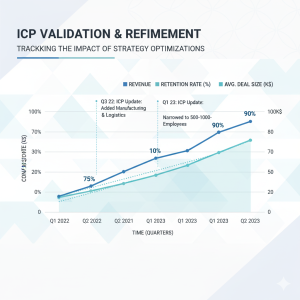
Conclusion
Defining your B2B Ideal Customer Profile (ICP) is the single most important strategic exercise for achieving predictable, scalable growth. It transforms your sales and marketing efforts from an expensive, generalized approach into a focused, high-impact campaign. By moving beyond simple demographics and systematically analyzing firmographic data, technographics, pain points, and profitability, you equip your teams to target the companies that are not just willing to buy, but are destined to succeed with your solution.
In a competitive global market, particularly for companies catering to diverse clients in India and abroad, precision is survival. Invest the time in this blueprint, and watch your business move from guessing games to guaranteed, high-value growth.
I hope you find the above content helpful. For more such informative content, please visit SalesDemand.
FAQs
Q1: What is the main difference between an ICP and a Buyer Persona? A: The ICP describes the ideal company (B2B entity), focusing on attributes like industry and size (firmographics). The Buyer Persona describes the ideal individual within that company, focusing on their role, motivations, and pain points.
Q2: How often should we review and update our B2B Ideal Customer Profile (ICP)? A: You should review and update your ICP at least quarterly. It should also be immediately reviewed after any major product launch, expansion into a new market, or a significant change in competitive landscape.
Q3: Can a B2B company have more than one Ideal Customer Profile (ICP)? A: Yes. If you have distinct product lines or service offerings that solve fundamentally different problems for different market segments (e.g., one solution for enterprise and one for mid-market), you should develop a separate ICP for each.
Q4: Which team is primarily responsible for defining the ICP? A: Defining the ICP is a collaborative effort led by Marketing and Sales leadership, with critical input from the Product team (for product-market fit) and the Customer Success team (for retention and LTV data).
Q5: What are Technographics and why are they important for the ICP? A: Technographics refer to the technology stack and software tools a company uses. They are crucial for the ICP because they determine compatibility, integration needs, and potential upsell opportunities.
Q6: How does having an ICP reduce Customer Acquisition Cost (CAC)? A: By filtering out poor-fit leads early, your sales teams spend less time qualifying, and your marketing budget is directed only towards channels and campaigns that target high-conversion prospects. This efficiency directly lowers your overall CAC.
Q7: Is ICP relevant for services-based businesses, or just software companies? A: The B2B Ideal Customer Profile (ICP) is absolutely relevant for all B2B businesses, including services. For services firms, the ICP helps define the client size, complexity of their problems, and willingness to pay premium rates for specialized expertise.
B2B Appointment Setting: The Complete Guide to Smarter Lead Generation
Picture this: your sales team is chasing dozens of leads, the pipeline looks impressive, but when it comes to closing deals, the results just don’t add up. Sound familiar? You’re not alone.
The problem isn’t always about generating leads, it’s about generating the right ones and turning them into real sales conversations. That’s where B2B appointment setting comes in.
Think of it as the bridge between marketing and sales. Instead of wasting time on cold leads, appointment setting ensures your reps spend their time with decision-makers who are actually interested in what you offer. And thanks to AI, automation, and smarter strategies, the process is no longer a grind, it’s efficient, scalable, and far more effective.
In this blog, we’ll break down everything you need to know about B2B appointment setting, from how it works to the tools and strategies that can take your sales pipeline from “busy” to “profitable.”
1# Understanding B2B Appointment Setting in the AI Era
At its core, B2B appointment setting is about arranging sales meetings between your team and qualified prospects. Instead of pursuing every lead in the pipeline, the process ensures that only the most relevant and high-intent prospects make it to your sales reps’ calendars.
Traditionally, appointment setting was manual, involving cold calls, generic emails, and repetitive follow-ups. But the modern approach, especially when supported by AI and automation, is far more sophisticated.
Here’s how AI is reshaping appointment setting today:
- Smarter targeting: AI analyzes firmographics, demographics, and intent signals to identify decision-makers.
- Predictive scoring: Algorithms rank prospects based on their likelihood to convert.
- Real-time engagement: AI chatbots engage leads 24/7, filtering and nurturing them before passing them to sales.
- Seamless scheduling: Virtual assistants automatically book meetings at times that suit both parties.
- This evolution ensures that appointment setting is no longer just a sales function, it’s a strategic growth engine.
2# Why B2B Appointment Setting Is Essential for Lead Generation
The B2B sales cycle is very different from B2C. Decision-making often involves multiple stakeholders, higher-value transactions, and longer timelines. Without an effective appointment setting process, leads can easily fall through the cracks.
Here’s why B2B appointment setting is indispensable:
Improves Lead Quality: Instead of chasing every prospect, you focus only on those with genuine interest and authority.
- Saves Time and Resources: Sales reps don’t waste hours calling unqualified leads, they engage with decision-makers.
- Boosts Conversions: Meetings with the right people accelerate deal closures.
- Aligns Marketing and Sales: Appointment setting acts as a bridge, ensuring that leads generated by marketing are effectively handed off to sales.
- Provides Consistency: Creates a predictable flow of opportunities into the pipeline.
For many B2B marketers, converting qualified leads into appointments remains a top priority and appointment setting makes that possible.
3# The Process: How AI Enhances B2B Appointment Setting
Let’s look at the step-by-step process of B2B appointment setting and how AI makes each stage smarter.
1. Data Collection and Enrichment
- Traditional: Manual research on LinkedIn, company websites, and databases.
- With AI: Tools like ZoomInfo and Clearbit automatically enrich lead profiles with contact details, intent data, and buying signals.
2. Lead Qualification and Scoring
- Traditional: Gut instinct or simple checklists.
- With AI: Predictive scoring ranks leads based on engagement, budget, and conversion probability.
3. Personalized Outreach
- Traditional: Generic email blasts or cold calls.
- With AI: Smart tools send dynamic, hyper-personalized emails or LinkedIn messages at the right time.
4. Scheduling Appointments
- Traditional: Endless back-and-forth emails to confirm availability.
- With AI: Automated scheduling tools like Calendly or Drift book meetings instantly.
5. Follow-Up and Nurturing
- Traditional: Manual reminders and inconsistent follow-ups.
- With AI: Automated workflows send timely nudges, reminders, and personalized content.
6. Feedback and Optimization
- Traditional: Basic tracking of appointments scheduled.
- With AI: Analytics dashboards show what’s working, allowing you to refine campaigns continuously.
Result: Higher efficiency, fewer missed opportunities, and more qualified conversations.
4# B2B Appointment Setting vs. Lead Generation: Key Differences
Although related, appointment setting and lead generation serve distinct purposes.
| Aspect | Lead Generation | B2B Appointment Setting |
|---|---|---|
| Objective | Identify and attract potential buyers | Convert prospects into meetings |
| Methods | SEO, ads, content marketing, webinars | Calls, AI scheduling, personalized outreach |
| Outcome | A database of leads | Confirmed meetings with decision-makers |
| Focus | Volume of leads | Quality of leads |
Think of it this way:
- Lead generation fills the funnel.
- B2B appointment setting activates the funnel and moves prospects closer to conversion.
5# Six Proven B2B Appointment Setting Strategies (Enhanced with AI)
1. Automate Lead Qualification
Use AI chatbots to instantly qualify leads based on budget, need, and decision-making authority before passing them to sales.
2. Leverage Predictive Analytics
AI can analyze historical data to predict which leads are most likely to convert, helping sales teams focus on high-potential prospects.
3. Personalize Outreach Campaigns
Generic emails are dead. AI-powered platforms tailor content and messaging to each lead’s industry, role, and interests.
4. Optimize Timing with AI
Tools like Outreach.io and HubSpot suggest the best time to send messages or make calls for maximum engagement.
5. Integrate AI with CRM Systems
AI-powered CRMs centralize customer data, ensuring seamless communication and tracking throughout the buyer’s journey.
6. Re-Engage Dormant Leads
AI can detect signals of renewed interest from previously cold leads and automatically restart the engagement process.
Example: One SaaS company implemented AI-powered appointment setting and achieved a 32% increase in meetings booked with enterprise clients in just 90 days.
6# Best Tools for B2B Appointment Setting
Choosing the right tools can supercharge your appointment setting efforts. Here are some popular options:
- ZoomInfo – For lead enrichment and contact accuracy.
- HubSpot CRM – For AI-driven lead nurturing and automated outreach.
- Drift – AI chatbots that qualify and engage leads 24/7.
- Outreach.io – For automating sequences and follow-ups.
- Calendly (AI integrations) – Smart scheduling that eliminates back-and-forth emails.
- Salesforce Einstein – Predictive analytics and AI-powered lead scoring.
7# Benefits of B2B Appointment Setting for Companies
Implementing B2B appointment setting especially with AI support, offers measurable benefits:
- Better ROI – Focuses resources on high-quality leads.
- Higher Conversion Rates – More meetings with real decision-makers.
- Time Efficiency – Automates repetitive tasks, freeing sales teams to focus on closing deals.
- Scalability – Manage large databases and multiple campaigns without adding headcount.
- Improved Collaboration – Aligns marketing and sales around qualified leads.
- Competitive Advantage – Businesses that adopt AI-driven appointment setting gain an edge in saturated markets.
Companies using AI for lead qualification often report up to a 40–50% increase in sales-ready leads.
Conclusion
In today’s competitive landscape, generating leads is not enough. What truly drives revenue is converting those leads into meaningful sales conversations. That’s exactly what B2B appointment setting delivers.
By leveraging AI for lead generation alongside proven strategies and modern tools, businesses can create a streamlined process that saves time, improves lead quality, and boosts conversions.
For B2B companies looking to grow smarter, not harder, appointment setting isn’t just an option; it’s a necessity.
I hope you find the above content helpful. For more such informative content, please visit SalesDemand.
FAQs
- What does a B2B appointment setter do today?
They qualify prospects, engage leads, and schedule meetings between sales reps and decision-makers, often using AI-powered tools for efficiency. - What industries benefit the most from B2B appointment setting?
Industries such as SaaS, IT, consulting, manufacturing, and healthcare benefit the most due to longer, more complex sales cycles. - How long does it take to see results from B2B appointment setting?
Most companies see measurable results within 2–3 months, depending on their target market and approach. - Can AI replace human appointment setters?
AI improves efficiency, but human appointment setters are still essential for relationship-building and complex negotiations. A hybrid model works best. - How does B2B appointment setting improve lead quality?
By filtering out unqualified leads and focusing on decision-makers who show genuine buying intent. - What tools are best for B2B appointment setting?
Popular tools include HubSpot, ZoomInfo, Drift, Calendly, Outreach.io, and Salesforce Einstein. - Is B2B appointment setting suitable for small businesses?
Yes. AI-powered tools make appointment setting scalable and affordable for SMEs as well as large enterprises.
What Is Demand Generation Marketing? Strategies, Examples, and Best Practices
Did you know that 70% of B2B buyers research online before ever speaking to a sales representative?. In today’s digital-first landscape, decision-makers are consuming blogs, case studies, podcasts, and webinars long before they even consider filling out a demo form.
This shift in buyer behavior explains why businesses are no longer satisfied with traditional lead generation alone. What they need is a strategy that not only captures leads but also creates market awareness, builds trust, and generates demand over time.
That’s where Demand Generation Marketing comes in.
In this blog, we’ll answer the most pressing questions about demand generation marketing – from what it is, why it matters, how it differs from lead generation, to strategies, metrics, and FAQs. By the end, you’ll have a clear roadmap to make demand generation work for your business.
1# What is Demand Generation Marketing?
At its core, Demand Generation Marketing is the practice of building awareness and interest in your product or service long before a potential buyer is ready to purchase.
Think of it as storytelling + problem-solving + trust-building. Instead of pushing for immediate conversions, demand generation nurtures curiosity, educates prospects, and positions your brand as the obvious choice when the buyer finally decides to act.
For example, a SaaS company offering project management software may not immediately sell subscriptions. Instead, it might publish blog posts on remote team collaboration, host webinars on productivity, and share industry benchmarks. This attracts the right audience, educates them, and keeps the brand top-of-mind until they’re ready to buy.
2# Why is Demand Generation Marketing Important Today?
B2B buyers are overwhelmed. Every day, they’re bombarded with ads, emails, and cold calls. What they crave isn’t more sales pitches but authentic value.
Here are three reasons why demand generation marketing is essential:
- Shifting buyer journey: According to Gartner, buyers spend only 17% of their time meeting with suppliers when considering a purchase. The rest is spent doing independent research. If you’re not visible during that research phase, you’re invisible.
- Longer B2B sales cycles: Complex purchases take months, sometimes years. Demand generation keeps your brand relevant throughout that journey.
- Trust drives decisions: Edelman’s Trust Barometer shows that 81% of buyers need to trust a brand before buying. Demand generation builds that trust through consistent, value-driven engagement.
3# How is Demand Generation Marketing Different from Lead Generation?
This is one of the most common questions. While both are connected, they’re not the same.
| Aspect | Demand Generation Marketing | Lead Generation |
|---|---|---|
| Focus | Building awareness & interest | Capturing contact details |
| Timeline | Long-term relationship building | Short-term conversions |
| Tactics | Content, thought leadership, brand storytelling | Forms, landing pages, gated eBooks |
| Buyer Stage | Early awareness of education | Mid to late buying stage |
Simple analogy: Demand generation is like preparing the soil – educating and nurturing it. Lead generation is planting the seed when the soil is ready. You need both, but without healthy soil (demand), seeds (leads) won’t grow.
4# What are the Core Pillars of Demand Generation Marketing?
To make demand generation effective, businesses need to focus on five pillars:
- Content and Education
- Blogs, guides, case studies, podcasts, and webinars that address customer pain points.
- Example: A cybersecurity firm publishing a free guide on “Top 10 Threats for 2025.”
- Brand Awareness & Distribution
- Building presence where your audience spends time – LinkedIn, industry forums, or niche podcasts.
- Paid ads and SEO amplify reach.
- Lead Nurturing & Workflows
- Automated yet personalized email sequences.
- Drip campaigns that share value rather than spam promotions.
- Sales & Marketing Alignment
- Shared goals, definitions, and data between teams.
- Example: agreeing on what qualifies as a “marketing qualified lead” (MQL).
- Measurement & Optimization
- Track not just leads, but engagement, brand lift, and pipeline influence.
- Use metrics to refine strategies continuously.
5# Which Strategies Work Best for Demand Generation Marketing?
Let’s answer some strategy-focused questions.
What role does content marketing play?
Content is the engine of demand generation. Educational blogs, videos, and reports help prospects identify problems and learn solutions. Content isn’t about selling; it’s about helping.
How do social media and communities drive demand?
B2B buyers spend hours in digital communities (LinkedIn groups, Slack channels, Reddit forums). By being active there, brands can engage authentically. Social media also humanizes your brand.
Why is account-based marketing (ABM) effective?
ABM focuses on high-value accounts with personalized campaigns. For instance, instead of targeting 1,000 random leads, you design campaigns for 50 key companies that fit your ICP (ideal customer profile). This ensures higher ROI.
How do paid and organic efforts work together?
Paid ads boost visibility fast, while SEO builds organic credibility long-term. Together, they balance demand creation (awareness) and demand capture (converting existing intent).
Should you use webinars, podcasts, and events?
Absolutely. Interactive formats like webinars and events allow real-time education and relationship-building. They also generate engagement metrics that guide sales outreach.
6# How to Build a Demand Generation Marketing Framework?
Here’s a roadmap, broken down into key questions:
- How do I define my ICP?
Interview customers, analyze CRM data, and identify common traits (industry, job role, challenges).
- Which channels should I prioritize?
Start with where your audience spends time: LinkedIn, industry newsletters, and SEO. Add paid campaigns later.
- How should I plan content distribution?
Repurpose one piece into multiple formats. Example: A whitepaper can become blogs, LinkedIn posts, infographics, and a webinar.
- What should I measure?
Don’t just count leads. Measure content engagement, brand mentions, pipeline impact, and customer lifetime value.
7# What Metrics Should You Track in Demand Generation Marketing?
Metrics should capture both early signals (leading indicators) and business results (lagging indicators).
- Leading indicators:
- Website traffic growth
- Content downloads (even ungated)
- Social media engagement
- Webinar registrations
- Lagging indicators:
- Marketing-qualified leads (MQLs)
- Pipeline growth
- Conversion rates (MQL → SQL → Customer)
- Customer lifetime value (CLV)
8# What Are Common Mistakes in Demand Generation Marketing & How to Avoid Them?
- Focusing only on gated content: Not every asset should be behind a form. Give away value upfront.
- Over-reliance on paid ads: Paid boosts reach, but organic content builds credibility and sustainability.
- Ignoring sales & marketing alignment: Without collaboration, even strong demand fizzles out.
- Not tracking the right metrics: Vanity metrics (likes, views) don’t equal revenue. Tie marketing to pipeline outcomes.
- Expecting instant results: Demand generation is a marathon, not a sprint. Give campaigns time.
Conclusion
The short answer: yes. Buyers today want brands that educate, engage, and build trust – not just sell. Demand generation marketing ensures your business stays relevant throughout the buyer journey, driving not just leads but sustainable growth.
For B2B organizations like yours, especially in competitive tech and SaaS spaces, investing in demand generation marketing is no longer optional – it’s a growth strategy.
At Sales-Demand, we help businesses design and execute demand generation strategies that align marketing with sales, drive awareness, and generate revenue-ready opportunities.
FAQs
- Is demand generation only for enterprise businesses?
No. Small and mid-sized companies can benefit by building trust and visibility in their niche. - What is the purpose of demand generation?
To build awareness, educate potential buyers, and create long-term interest that drives qualified opportunities. - How to increase demand generation?
Use data-driven campaigns, personalized content, intent data, and multi-channel strategies to reach and engage buyers. - Does demand generation replace lead generation?
No, they complement each other. Demand gen creates awareness, while lead gen captures that awareness. - How long does it take to see results?
Typically 3–6 months, depending on industry and investment. It’s a long-term play. - How can small businesses implement demand generation on a budget?
Focus on content marketing, SEO, and community engagement. Leverage organic channels before investing heavily in paid ads. - What is the difference between Demand Generation and Lead Generation?
Demand generation focuses on creating awareness and interest, while lead generation captures and qualifies prospects for sales. - What is the difference between demand creation and demand capture?
- Demand creation: educating and generating awareness where none exists.
- Demand capture: converting existing intent into leads or sales.
Contact us today to explore how we can power your demand engine.
Lead Nurturing Strategies: How to Boost Conversions and Business Growth
“People don’t buy what you do; they buy why you do it.”
— Simon Sinek
Did you know that nurtured leads result in 50% more sales-ready prospects at 33% lower cost, and they make 47% larger purchases compared to non-nurtured leads?
If you’re still treating lead nurturing as an optional marketing tactic, you’re likely leaving opportunities and revenue on the table. The path from capturing attention to closing deals isn’t a sprint; it’s a carefully guided journey. This is where strategic lead nurturing transforms passive interest into committed customers.
Let’s explore how modern lead nurturing, powered by multi-channel tactics, data-backed personalization, and automation, can fuel sustainable business growth.
What Is Lead Nurturing?
Lead nurturing is the systematic process of engaging prospective customers with relevant, timely content and interactions until they are ready to buy. It uses targeted messaging, multi-channel touchpoints, and behavior- or time-based automation to progress leads from awareness → consideration → decision.
In practice, nurturing intersects three disciplines:
- Content marketing (providing useful information at each stage),
- Marketing automation (delivering the right content at the right time),
- Sales enablement (ensuring qualified leads move smoothly to sales).
Why Lead Nurturing Drives Business Growth
Lead nurturing improves growth in three measurable ways:
- Higher conversion rates: nurtured prospects are more qualified and convert at higher rates.
- Lower acquisition costs: By improving conversion efficiency, you reduce the cost to acquire a customer.
- Larger deal sizes and retention: nurtured relationships build trust and open opportunities for upsell and cross-sell.
Clear, consistent nurture programs shorten sales cycles and improve forecast accuracy. If you want predictable pipeline growth, nurturing is the foundation.
Core Principles of Successful Lead Nurturing
Before building workflows, embed these principles into your program:
- Relevance: Always match content to the lead’s pain, role, and stage.
- Cadence (not frequency): Maintain consistent contact without spamming quality over quantity.
- Personalization: Use role or firmographic data to tailor messaging.
- Measurement: Decide KPIs up front and instrument them.
- Alignment: Coordinate marketing and sales on definitions, handoffs, and SLAs.
Keep these principles visible – they guide decisions when you create content, set automation logic, or prioritize accounts.
How to Build an Effective Lead Nurturing Program
Step 1 – Define your ICP and buyer stages
Action items:
- Document your Ideal Customer Profile (ICP): industry, company size, revenue band, geography, and typical job titles involved in purchase decisions.
- Map buyer stages: Awareness, Consideration, Decision, and Post-Purchase (onboarding/expansion).
Why it matters: Without ICP and stage clarity, messaging will be generic and ineffective.
Step 2 – Audit and map existing content to the journey
Action items:
- Inventory your content (blog posts, ebooks, case studies, webinars, videos).
- Create a content map: assign each asset to a buyer stage and persona.
Outcome: You’ll quickly see content gaps (e.g., no decision-stage ROI pieces) and know what to create first.
Step 3 – Segment your leads for targeted outreach
Common segmentation criteria:
- Role (e.g., CTO vs. Head of Ops)
- Company size
- Industry
- Behavior (pages visited, downloads, webinar attendance)
- Lead source (organic, paid, event)
Example: A lead from a healthcare domain who downloaded a compliance whitepaper needs different nurture content than a retail IT lead who watched a product demo.
Step 4 – Build lead scoring that drives handoffs
A simple scoring model:
- +10 points: Attended a webinar
- +8 points: Opened 5+ emails in 30 days
- +15 points: Requested pricing/demo
- -5 points: Unsubscribed from newsletter
Define a threshold (e.g., 70 points) where marketing auto-notifies sales to initiate human outreach. Review and refine scores monthly based on conversion data.
Step 5 – Design nurture streams and automation workflows
Create 3–5 core nurture streams by persona & stage. Each stream contains 6–10 touchpoints (email + supporting channel). Example: Awareness stream (6 weeks):
- Day 0 — Welcome email + overview
- Day 3 — Thought leadership article (pain context)
- Day 10 — Short case study (relevance proof)
- Day 18 — Educational webinar invite
- Day 25 — ROI calculator offer (interactive)
- Day 35 — Demo invitation/sales outreach
Include behavioral triggers: if a lead clicks the ROI calculator, escalate to a “high intent” stream with an immediate sales alert.
Step 6 – Create content tailored to each touchpoint
Content types to consider:
- Awareness: Industry reports, problem-centric blog posts, short videos.
- Consideration: Case studies, whitepapers, product comparisons, webinars.
- Decision: ROI calculators, tailored demos, testimonial bundles, free trials.
Tip: For decision-stage content, use account-specific case studies and metrics they reduce friction.
Step 7 – Use multi-channel engagement
Don’t rely solely on email. Combine:
- Email (primary nurture channel)
- Retargeting ads (brand recall)
- LinkedIn outreach or sponsored content (B2B targeting)
- Web personalization (dynamic landing pages)
- Events/webinars (deep engagement)
Synchronized messages across channels feel cohesive and increase trust.
Step 8 – Personalization at scale (practical tactics)
Use dynamic fields and conditional content in emails and landing pages. Examples:
- Subject line: “How [Company] can reduce onboarding time by 30%”
- Email open line: “Hi [First name], I noticed you downloaded our security checklist – here’s a quick case study… ”
Advanced: use intent data and site behavior to swap hero content on landing pages (if the user viewed pricing, show condensed ROI).
Step 9 – Test, measure, and iterate
A/B tests to run:
- Subject lines (personalized vs. generic)
- Email length (short vs. long)
- CTA types (demo vs. ROI calculator)
- Send times and cadences
Key metrics:
- Open and click-through rates (engagement)
- MQL → SQL conversion rate (handoff quality)
- Lead → Opportunity conversion (pipeline impact)
- Time to conversion (sales cycle length)
- Customer Acquisition Cost (CAC) and Lifetime Value (LTV) improvements
Use these insights to refine messaging, timing, and scoring.
Practical Examples & Ready-to-Use Templates
Sample 1 – Welcome Email (short, day 0)
Subject: Welcome, [First name] – resources you’ll find useful
Body:
Hi [First name],
Thanks for downloading “[Asset title].” I thought you might also find this short case study useful: [link]. If you’d like, I can schedule a 15-minute chat to understand your priorities.
Best,
[Sender name], [Title]
Sample 2 – Mid-Stage Case Study Email (day 10)
Subject: How [Peer Company] cut costs by 20% – short read
Body:
Hi [First name],
When [Peer Company] faced [pain point], they implemented [solution]. Within 6 months, they reduced [metric] by 20%. I’ve attached the two-page case study, which highlights the approach, timeline, and results. Would you like a personalized breakdown for [Company]?
Regards,
[Sender]
Sample 3 – Re-engagement Email (30+ days no activity)
Subject: Still relevant: [Topic] – worth a quick look?
Body:
Hi [First name],
We haven’t heard back on whether priorities have shifted. I understand. If you’re still exploring [topic], here’s a quick checklist that helps you assess readiness: [link]. If not, would you like to pause these emails?
Thanks,
[Sender]
Common Mistakes (and How to Fix Them)
- Over-emailing leads
Fix: Set cadence caps and use engagement decay logic (slow down after 3 unopened emails). - Generic content for all stages
Fix: Audit and map content to journey stages; produce 2–3 decision-stage assets immediately. - No defined handoff to sales
Fix: Publish a Service Level Agreement (SLA) between marketing and sales: lead qualification rules, response times, and feedback loop. - Ignoring mobile experience
Fix: Design all emails and landing pages mobile-first and run tests on devices.
Tools & Tech Stack (practical shortlist)
- Marketing Automation / ESP: HubSpot, Marketo, Pardot, ActiveCampaign
- Account/Intent Data: 6sense, Bombora, ZoomInfo, Clearbit
- Web Personalization: Optimizely, VWO, Unbounce (for dynamic landing pages)
- Ad Retargeting: LinkedIn Matched Audiences, Google Display
- Analytics / BI: Google Analytics, Looker, HubSpot Reports
Choose tools that integrate with your CRM to keep data unified.
Example 8-Week Nurture Campaign (timeline)
Week 1: Welcome email + blog digest
Week 2: Problem-focused article + soft CTA
Week 3: Case study (similar company) + mid-stage survey
Week 4: Webinar invite (value-based)
Week 5: Webinar follow-up + ROI calculator
Week 6: Personalized video or one-pager for decision-makers
Week 7: Pricing explainer/demo CTA
Week 8: Direct sales outreach for leads above score threshold
This cadence mixes content, events, interactive tools, and sales touches to move prospects forward efficiently.
Measurement Framework – What to Track Weekly vs Monthly
Weekly:
- New leads entered to nurture streams
- Email open and CTR per stream
- Number of leads crossing scoring thresholds
Monthly:
- MQL → SQL conversion rate
- Average time in funnel
- CAC by channel (after nurture)
- Revenue influenced by nurture
Quarterly:
- LTV by cohort
- Program ROI (revenue influenced ÷ program cost)
Final Checklist Before Launching Your First Program
- ICP and buyer stages documented
- Content mapped and gaps identified
- 2–3 decision-stage assets created
- Lead scoring rules and thresholds set
- Automation workflows built and tested
- Sales SLA is published and agreed
- Multi-channel plan (email + LinkedIn + retargeting) ready
- Analytics dashboards set up for weekly monitoring
Conclusion
Lead nurturing is not a side activity; it is the engine that converts interest into measurable revenue. When you combine disciplined segmentation, targeted content mapped to the buyer’s journey, automation, and close sales-marketing alignment, you create a repeatable system that reduces CAC, shortens sales cycles, and increases average deal value.
I hope you find the above content helpful. For more such informative content, please visit SalesDemand.
Make B2B Lead Generation Content Effective, Not Corporate
Why “Corporate-Sounding” B2B Content Doesn’t Convert
Too much B2B content sounds like a policy manual. The facts are right, but the tone is lifeless. Buyers don’t connect with companies; they connect with people. And when content feels robotic, conversions drop
That’s the problem with most B2B lead generation content. It’s written for “companies” instead of the people who make buying decisions. The result? Content that’s technically correct but emotionally disconnected.
Here’s the reality: every B2B buyer is a human first. They have KPIs and business goals, sure. But they also have emotions, fear of making the wrong choice, frustration with broken processes, and a strong desire to be seen as innovative.
If your content ignores the human side, you’ll lose attention (and leads). If you humanize your content, you’ll build trust, connect with decision-makers, and drive higher-quality conversions.
Below, we’ll explore 8 proven strategies that transform stiff B2B lead generation content into engaging, conversion-focused storytelling.
1# Start With Buyer Emotions, Not Just Pain Points
Traditional personas often stop at surface-level pain points like “reduce costs” or “improve efficiency.” But in real life, business decisions are also emotional.
Think about it:
- A CMO might be frustrated with campaigns that generate clicks but not qualified leads.
- A sales leader might feel stressed about pipeline targets slipping away.
- A marketing ops manager might be worried about the accuracy of their lead database.
Why this matters: Content that acknowledges emotions creates instant relatability.
Instead of: “Our solution reduces data errors by 20%.”
Try: “Tired of wasting hours cleaning spreadsheets? Here’s how to fix it once and for all.”
Pro Tip: Write down one emotional hook for each piece of lead generation content. Use it in the intro or CTA to grab attention fast.
2# Speak Like a Colleague, Not a Vendor
Too much B2B content drowns in buzzwords. Sentences like “synergize scalable frameworks for optimal ROI” impress no one.
Your readers don’t want a pitch; they want clarity.
Guidelines for a conversational tone:
- Use short sentences (under 20 words).
- Replace jargon with everyday phrases.
- Write like you’re explaining a concept to a colleague over coffee.
Example rewrite:
- Vendor-speak: “Our AI-driven platform maximizes MQL throughput.”
- Human-speak: “We use AI to help your reps spend less time chasing bad leads.”
When content feels natural, buyers are more likely to stay engaged and take action.
3# Turn Case Studies Into Relatable Stories
Case studies are gold in lead generation, but most read like research reports: flat, technical, and impersonal.
Instead, frame them as stories with a clear beginning, middle, and end.
Storytelling framework:
- The Hero → Who is the client?
- The Struggle → What challenge did they face?
- The Turning Point → How was the solution applied?
- The Happy Ending → What results did they achieve?
Example:
A SaaS company struggled with duplicate leads. Sales reps wasted 15 hours weekly cleaning spreadsheets instead of closing deals. After implementing our CRM + Data Cleaning Services, they cut wasted hours by 70% and hit pipeline goals within one quarter.
Notice how this version feels human and relatable, not just statistical.
4# Make Your Content Scannable
Decision-makers don’t read blogs word-for-word; they scan. If your content is presented as a dense wall of text, you’ll lose them.
Here’s how to design content for scanners:
- Use numbered lists.
- Add bullet points for steps or takeaways.
- Bold key phrases so they pop out at a glance.
- Keep paragraphs short (2–3 sentences).
Pro Tip: Think of your blog post as a landing page. If readers can get the main idea in 30 seconds of skimming, you’ve done it right.
5# Blend Data With Relatable Analogies
Numbers establish credibility, but they can also feel cold. Analogies bridge the gap between data and real understanding.
- Data alone: “61% of marketers say lead quality is their biggest challenge.”
- Data + analogy: “Think of it like fishing in the wrong pond. Six out of 10 marketers feel they’re casting nets all day but catching empty shells.”
This technique makes complex insights memorable and easy to share.
6# Add Visual and Interactive Elements
Words alone can’t always carry the message. Visuals make content more engaging and digestible.
Options include:
- Infographics to simplify multi-step processes
- Screenshots of dashboards, workflows, or campaign results
- Short videos or GIFs embedded into blogs
- Interactive tools (e.g., ROI calculators, checklist downloads)
Pro Tip: Incorporate customer quotes as pull-out graphics. A one-sentence testimonial like “This solution saved us 12 hours a week” stands out more than a paragraph of self-praise.
7# Build Trust Through Micro-Moments
Trust in B2B isn’t built through one big case study; it’s reinforced in small, consistent ways.
Examples of credibility-building micro-moments:
- Citing third-party research from Gartner, Forrester, or industry leaders
- Embedding mini-wins like “Cut lead response time from 12 hours to 3”
- Adding author bios that showcase subject-matter expertise
- Sprinkling in client logos or testimonials across blogs
Each of these adds subtle proof points that reassure readers they’re in good hands.
8# End With Human-Centered CTAs
Most CTAs sound robotic: “Submit form.” “Request demo.” That doesn’t inspire action.
Instead, make CTAs specific and benefit-driven:
- Instead of: “Download case study” → “See how a SaaS firm doubled SQLs in 90 days.”
- Instead of: “Book a demo” → “Let’s talk about your pipeline goals no slides, just solutions.”
Placement tip:
- Use a soft CTA mid-article (e.g., “Learn more about our Lead Generation Services”).
- Close with a strong CTA that ties back to the reader’s challenge.
Bonus Strategies to Go Even Further
1. Use Social Proof Across Content
Buyers trust peers more than vendors. Include logos, client quotes, or “X companies trust us” banners to reinforce credibility.
2. Personalize Nurture Follow-Ups
When someone downloads a guide, don’t send a generic email. Reference the specific content they engaged with: “Since you read our piece on cleaning CRM data, here’s a checklist to help you audit your system.”
This shows attentiveness and improves conversion from content → sales conversations.
Conclusion: People Buy From People
B2B buyers may have complex needs and long sales cycles, but at the end of the day, they’re still people who respond to clarity, empathy, and trust.
When you humanize your lead generation content, you’re not dumbing it down; you’re making it resonate. You’re showing prospects that you understand their struggles, value their time, and can help them achieve meaningful wins.
Book a Strategy Call today and see how our Lead Generation Services can help you turn conversations into conversions.
Proven Methods to Leverage Targeted ABM Content for Better ROI
“Marketing is no longer about the stuff you make, but the stories you tell.”
– Seth Godin
Did you know that 87% of B2B marketers say Account-Based Marketing (ABM) delivers higher ROI than any other marketing strategy? In today’s business world, decision-makers are bombarded with generic emails, cold calls, and one-size-fits-all campaigns. The truth is, mass marketing no longer resonates with high-value accounts.
To stand out, B2B companies must move beyond volume-driven campaigns and invest in targeted ABM content hyper-personalized marketing assets designed to engage decision-makers at the right time, in the right way.
This blog explores proven methods to leverage ABM content for driving better ROI, with practical tips, real-world examples, and the latest trends.
1# What is Targeted ABM Content?
Targeted ABM content refers to marketing assets designed specifically for a defined set of high-value accounts, rather than a broad audience. Unlike generic B2B content that aims to attract traffic in volume, targeted ABM content is crafted with precision; it speaks directly to an account’s industry, business model, decision-makers, and unique challenges.
For example, instead of publishing a one-size-fits-all whitepaper, a company might create a customized executive report for a handful of enterprise accounts, highlighting market trends that directly impact them. This level of exclusivity transforms content from a passive information piece into a strategic tool for influence and relationship-building.
Simply put, targeted ABM content is about quality over quantity: fewer assets, more personalization, and a stronger focus on driving measurable results within carefully chosen accounts.
2# Examples of Targeted ABM Content:
- Personalized Industry Briefings: Research-backed insights tailored to a specific vertical.
- One-to-One Email Sequences: Carefully written campaigns addressing account-level goals.
- Co-Branded Content: Whitepapers or reports created in collaboration with the target account to boost credibility.
- Executive LinkedIn Posts: Custom thought-leadership crafted to engage leaders within the target company.
- Account-Specific ROI Dashboards: Interactive tools showing potential savings or revenue impact for that account.
3# Why ABM Content is Essential for Modern B2B Growth
1. Precision Over Volume
Traditional demand generation is about reaching as many people as possible. But ABM flips the funnel, focusing instead on a smaller pool of high-value accounts. The content is personalized, relevant, and designed to convert specific targets rather than the masses.
2. ROI Advantage
- Companies using ABM report 48% more revenue per account and 30% higher marketing-attributed revenue.
- ABM-driven organizations experience up to 40% shorter sales cycles because the buying journey feels tailored.
3. Sales-Marketing Synergy
Unlike traditional marketing, ABM forces sales and marketing teams to work together. The content strategy is aligned with sales insights, ensuring every touchpoint builds trust and moves accounts toward conversion.
Method 1: Invest in High-Quality, Data-Driven Targeting
ABM content is only as good as the accounts you target. Poor data leads to wasted resources and irrelevant outreach.
Steps to Improve Targeting
- Use Intent Data: Platforms like Bombora, 6sense, or LinkedIn Insights reveal which accounts are actively researching your solution.
- Segment by Buying Stage: Early-stage accounts may prefer thought leadership, while late-stage buyers need ROI calculators or case studies.
- Enrich Databases: Tools like ZoomInfo or Clearbit help refine contact details, roles, and firmographics.
Pro Insight: Companies leveraging intent data have reported 3X higher engagement rates compared to those relying on static lists.
Method 2: Craft Hyper-Personalized ABM Content
Personalization is the backbone of ABM. Instead of generic blogs or guides, ABM content is tailored for a specific account, industry, or even decision-maker.
Content Ideas for Personalization
- Account-Specific Case Studies: Showcase how you solved challenges for similar companies in their industry.
- Custom Landing Pages: Design pages addressing unique pain points for each account.
- Executive Briefs: Deliver short, value-driven reports written for C-suite leaders.
- Video Messages: Personalized video introductions have 5X higher engagement than plain emails.
Example: Instead of sending a generic eBook to a logistics company, send a custom case study showing how your solution optimized supply chain efficiency for a peer company.
Method 3: Adopt an Omnichannel ABM Strategy
Relying on one channel is risky. B2B buyers interact across multiple platforms; your ABM content should follow them seamlessly.
Effective Channels for ABM Content
- Email Marketing: Triggered, account-specific campaigns.
- LinkedIn Campaigns: Sponsored posts or InMail targeted to decision-makers.
- Events/Webinars: Invite-only roundtables create exclusivity.
- Display Ads & Retargeting: Keep your brand visible throughout the buying journey.
Stat: B2B brands using at least 3 channels in ABM campaigns see 35% higher engagement rates compared to single-channel approaches.
Method 4: Use AI & Automation to Scale Personalization
AI has made ABM scalable without losing the personal touch.
How AI Enhances ABM Content
- Dynamic Content: AI customizes subject lines, visuals, and CTAs based on user behavior.
- Predictive Analytics: Identifies accounts most likely to convert soon.
- Chatbots: Provide instant, personalized responses to high-value prospects.
Stat: 79% of companies using AI in ABM have increased revenue, proving automation drives measurable ROI.
Check out our latest blog to learn more about how AI is transforming lead generation: AI-powered Lead Generation.
Method 5: Create Content for Every Stage of the Buyer’s Journey
Target accounts are rarely ready to buy immediately. ABM content should nurture them across the funnel:
- Awareness Stage: Blogs, industry reports, and thought-leadership content.
- Consideration Stage: Case studies, comparison guides, and webinars.
- Decision Stage: ROI calculators, personalized demos, and testimonials.
Pro Insight: Mapping ABM content to buyer stages increases lead-to-opportunity conversion rates by up to 25%.
Method 6: Align Sales and Marketing on ABM Content
One of the biggest ABM success factors is tight sales-marketing alignment.
Best Practices for Alignment
- Shared KPIs: Instead of vanity metrics, focus on pipeline velocity, deal size, and account engagement.
- Content Co-Creation: Sales should provide input on FAQs, objections, and pain points to shape ABM assets.
- Weekly Syncs: Regular alignment meetings ensure campaigns remain relevant.
Example: A SaaS firm aligned sales and marketing on ABM messaging and saw a 40% increase in deal velocity within 6 months.
Method 7: Leverage Interactive & Multimedia Content
Static PDFs no longer cut it. B2B buyers crave engaging, interactive content.
Interactive ABM Content Formats
- ROI calculators customized for each account.
- Interactive infographics with account-specific data points.
- Personalized video explainers.
- Interactive microsites designed for high-value accounts.
Stat: Interactive content generates 2X more engagement than static formats in ABM campaigns.
Method 8: Measure, Analyze, and Optimize ABM Content
ABM success isn’t just about content creation; it’s about measuring what works.
Key Metrics for ABM Content ROI
- Engagement Rate per Account (clicks, time spent, responses).
- Pipeline Velocity (how fast accounts move through the funnel).
- Deal Size Growth (average revenue per account).
- Win Rate Increase (percentage of targeted accounts converted).
Pro Insight: ABM leaders who continuously optimize campaigns see up to 50% higher revenue growth compared to laggards.
4# Real-World Case Snapshot: SaaS ABM Success
A mid-sized SaaS provider wanted to target Fortune 500 firms. Instead of mass campaigns, they launched a 3-month ABM program:
- Identified 50 high-value accounts using intent data.
- Built custom microsites with tailored content.
- Ran LinkedIn ABM campaigns with personalized InMail outreach.
- Nurtured accounts with executive briefs and exclusive webinars.
Results:
- 3X engagement compared to generic campaigns
- 40% shorter sales cycles
- 2X larger average deal size
Conclusion
Account-Based Marketing is no longer optional. For B2B companies, targeted ABM content is the proven engine for driving ROI. By combining:
- Data-driven targeting
- Personalized content
- Omnichannel outreach
- AI-driven personalization
- Sales-marketing alignment
- Interactive formats
Businesses can unlock higher conversions, larger deals, and long-term relationships with high-value accounts.
If your organization wants to convert fewer leads into more customers with higher revenue impact, it’s time to double down on ABM content strategies built for ROI.
I hope you find the above content helpful. For more such informative content, please visit SalesDemand.
8 Data-Driven Lead Strategies to Accelerate B2B Growth in 2025
Imagine if you could predict exactly which prospects are ready to buy before they even speak to your sales team.
That’s the power of a data-driven lead strategy. In today’s hyper-competitive B2B industry, gut feelings and guesswork are not enough. Companies that utilize real-time data, AI-driven insights, and measurable metrics are closing more deals, faster, and at a lower cost per acquisition.
Research shows that businesses using data effectively are 23× more likely to acquire customers, 6× more likely to retain them, and 19× more likely to be profitable. The message is clear: decisions backed by data don’t just improve lead quality, they transform the entire sales pipeline.
In this blog, we’ll explore eight proven strategies to help B2B professionals not just collect data but turn it into a high-performing lead generation engine that drives measurable business growth.
1# Why a Data-Driven Lead Strategy Matters
Firstly, data-driven organizations experience significantly better outcomes, leading to greater efficiency and predictability in acquiring and retaining clients. For example, companies that effectively nurture leads generate 50% more sales-ready leads at 33% lower cost. Meanwhile, marketing automation yields a 451% increase in qualified leads. These statistics highlight how aligning strategy around data-driven lead insights yields both volume and quality improvements.
1. Leverage AI-Driven Insights for Smarter Lead Generation
Artificial intelligence is now standard for modern B2B strategies. In 2025, over 75% of enterprises use AI in marketing operations, and 63% of companies using AI-powered lead scoring report significant improvements in lead quality. Real-world users report 50% increases in leads and appointments, a 40% jump in conversion rates, and up to 30% uplift when enriching lead data with AI tools.
71% of organizations regularly deploy generative AI (GAI) for content production and outreach personalization. Nearly 90% of marketers utilize GAI daily. Together, these capabilities mean that data-driven lead generation now hinges on harnessing AI-powered personalization and predictive analytics to scale performance efficiently.
2. Prioritize Quality Over Quantity: High-Intent Leads Win
Instead of focusing on sheer volume, successful B2B performers emphasize quality leads. 70% of marketers prioritize high-quality leads over quantity. Only 27% of leads are sales-ready when first captured, underscoring the importance of effective nurturing.
When companies adopt strong lead-nurturing programs, they generate 50% more sales-ready leads at significantly lower cost and benefit from leads that spend 47% more than non-nurtured ones. These outcomes speak directly to the efficiencies of a data-driven lead methodology.
3. Power Lead Generation with Strategic Content Marketing
Content marketing remains a cornerstone of effective data-driven lead generation. Recent data reveal that content marketing:
- Generates 3× more leads than traditional outbound methods while costing 62% less,
- Enables companies with active blogs to capture 68% more leads.
- It is relied upon by 87% of marketers for generating leads and nurturing audiences.
Further, video content stands out: 58% of B2B marketers name it as the most effective type for lead generation. Consistently, content remains a highly trusted channel for organic traffic and conversion.
4. Optimize SEO and Organic Reach
Search engine visibility remains a key vector for data-driven lead capture. Notable findings include:
- Organic search drives 53% of all B2B website traffic.
- Businesses investing in SEO see 14× more leads than those relying on paid ads.
- About 57% of B2B marketers say SEO generates more leads than any other initiative; SEO accounts for 14.6% of all B2B leads.
- A typical B2B buyer conducts 12 searches before purchase, making SEO optimization crucial.
By optimizing on-page structure, technical SEO, keywords, and featured snippets, businesses enhance their ability to attract high-intent prospects through search.
5. Utilize Multi-Channel & Social Strategies
Instead of relying on single-channel outreach, multi-channel marketing offers superior ROI. Multi-channel campaigns achieve a 31% lower cost per lead than single-channel initiatives. Social platforms are critical too 68% of marketers say social media helps generate leads, and LinkedIn dominates B2B, used by 79–89% of marketers for lead generation.
Social media closely rivals search as a source of B2B leads, with around 20% of marketers naming social as their top lead source vs. 27% for search. Video, interactive content, and retargeting further enhance engagement, while paid LinkedIn ads convert 2.5× better than other social platforms.
6. Strengthen Lead Nurturing & CRM Automation
Automation not only improves efficiency, it transforms outcomes. Companies using marketing automation experience a 451% increase in qualified leads. Lead-nurturing emails deliver 4–10× more responses vs. single blasts, and nurtured leads result in 20% more sales opportunities.
Integrating lead scoring, nurturing emails, and CRM creates a feedback-driven, data-driven lead system satisfying both marketing and sales teams. Businesses that align sales and marketing grow revenue 24% faster. This synergy strengthens conversion velocity and predictability.
7. Embrace ABM and Intent-Based Targeting
Account-Based Marketing (ABM) is now mainstream. Companies using ABM strategies generate 208% more revenue from marketing efforts and enjoy a 30% reduction in sales cycle length. ABM also improves client relationships by 56% and strengthens retention and upsell strategies.
Coupled with intent data and predictive AI, ABM helps B2B marketers deliver hyper-targeted content and outreach that resonates with specific accounts, fulfilling the promise of a data-driven lead model at scale.
8. Leverage Real-World Validation and Social Proof
No data-driven strategy is complete without credibility. While not strictly statistical, social proof from testimonials to industry endorsements reinforces brand reliability and helps convert leads.
Anecdotal insights enrich this approach. For instance, one B2B marketer shared:
“Using AI to analyze prospect websites and LinkedIn profiles for hyper-personalized outreach boosted our response rate from ~3% to nearly 12% almost overnight”.
Another emphasized that while AI expedites outreach, warm, human follow-up still delivers the highest conversions. These real voices underscore how data-driven lead generation thrives when automation complements, not replaces, personal connection.
2# Practical Examples of Data-Driven Lead Strategies in Action
Example 1: AI-Enhanced Prospecting
A SaaS company uses AI to monitor competitor product reviews, identifying dissatisfied customers. Outreach emails offering a free migration trial achieved a 15% response rate.
Example 2: Behavioral Retargeting
An IT service provider retargeted visitors who abandoned pricing pages with case studies about cost savings, resulting in a 22% lift in conversions.
3# Common Mistakes to Avoid in Data-Driven Lead Generation
- Chasing vanity metrics instead of sales-qualified leads.
- Ignoring data hygiene—outdated or duplicate records waste the budget.
- Over-automation—losing the human touch in messaging.
- Not testing landing pages, subject lines, or CTAs regularly.
4# Key Metrics to Track for Continuous Optimization
To keep your data-driven lead system efficient, monitor:
- Lead-to-customer conversion rate.
- Cost per qualified lead (CPQL).
- Marketing qualified leads (MQL) to sales qualified leads (SQL) ratio.
- Average deal size and revenue per lead.
5# Future Trends to Watch
Looking ahead:
- Predictive lead scoring will become more accurate as AI models evolve.
- Voice search optimization may impact B2B content strategies.
- Privacy-first marketing will grow in importance with stricter data laws.
Conclusion
A modern, data-driven lead strategy integrates AI-powered personalization, smart content creation, multi-channel SEO and social tactics, ABM, and nurturing flows all underpinned by measurable analytics. Together, these eight strategies form a robust ecosystem that fuels both high-quality lead generation and conversion optimization.
As B2B professionals, whether marketers, business leaders, or decision-makers, your path to growth lies in embracing these trends. Harness AI, invest in nurturing, optimize every channel, and preserve human connection. Continuously measure, adapt, and refine. By doing so, your data-driven lead generation won’t just survive, it will grow in 2025 and beyond.
I hope you find the above content helpful. For more such informative content, please visit SalesDemand.
